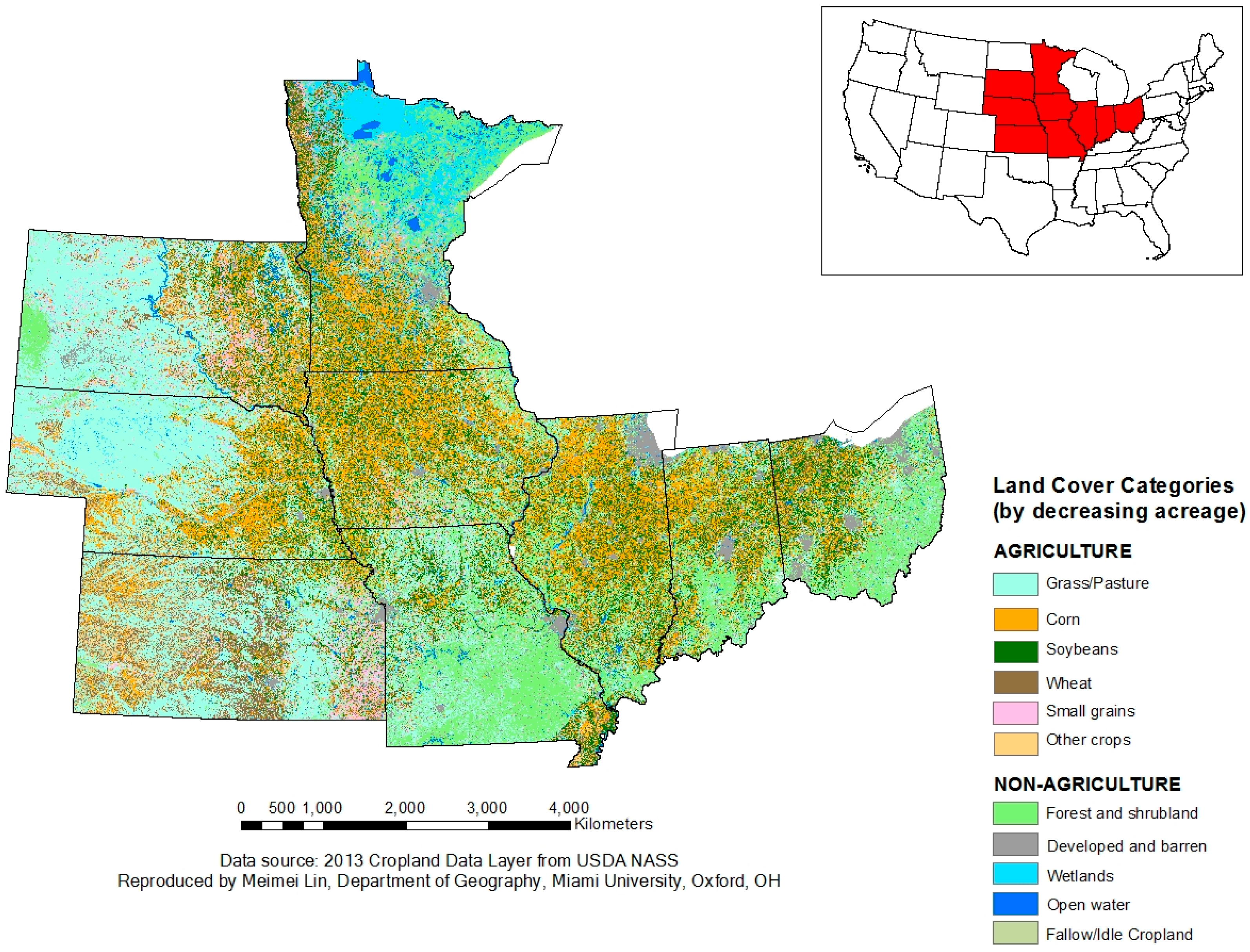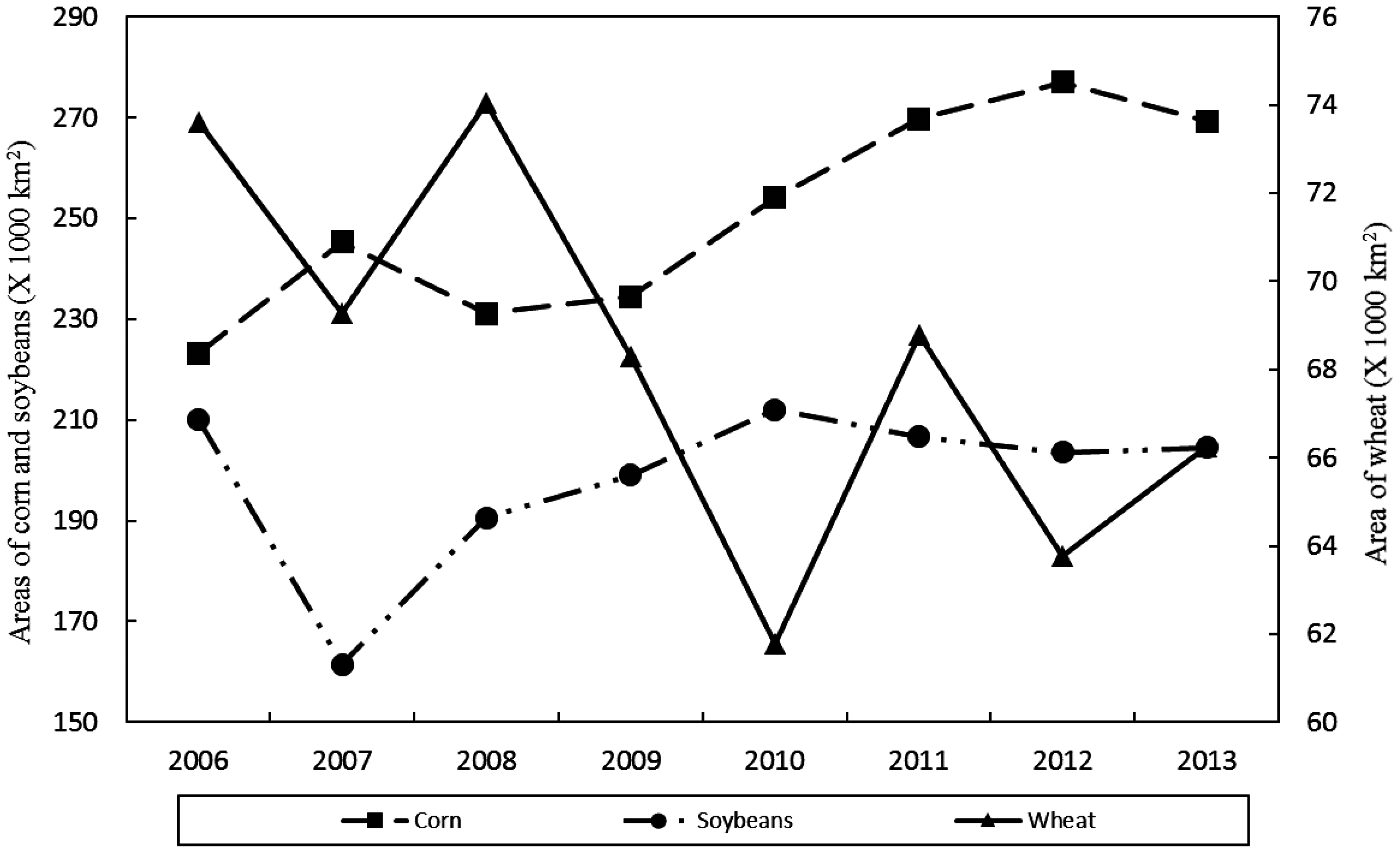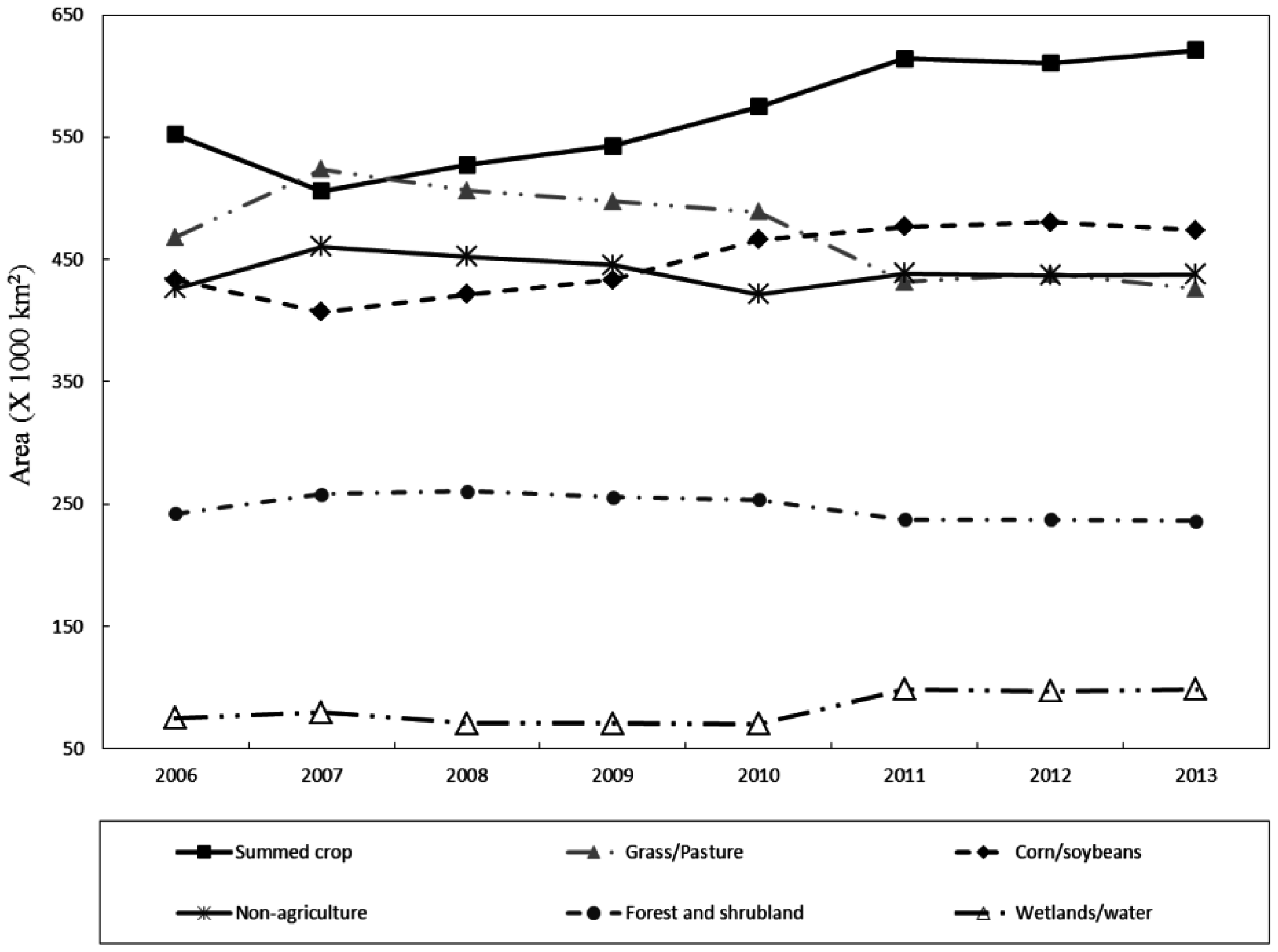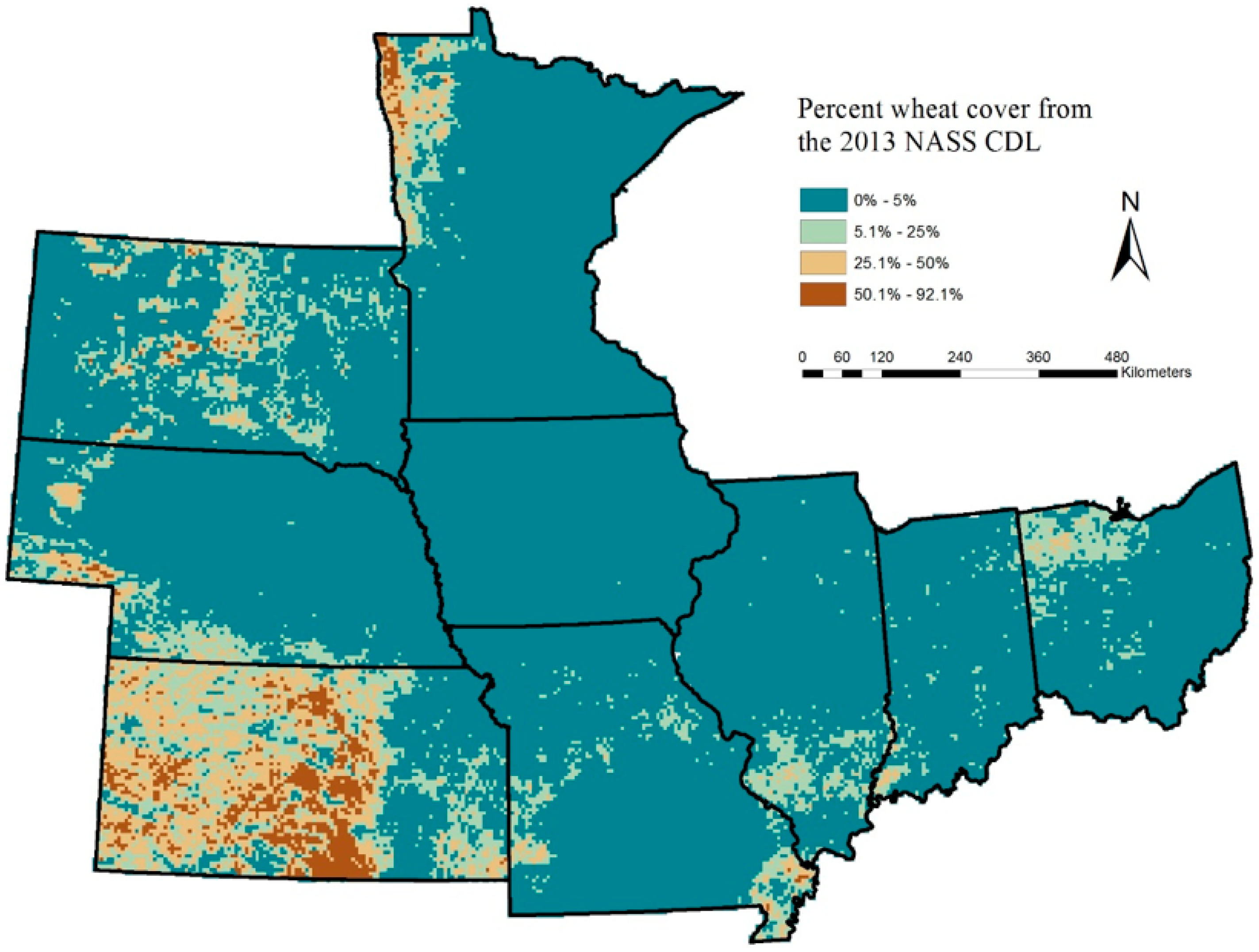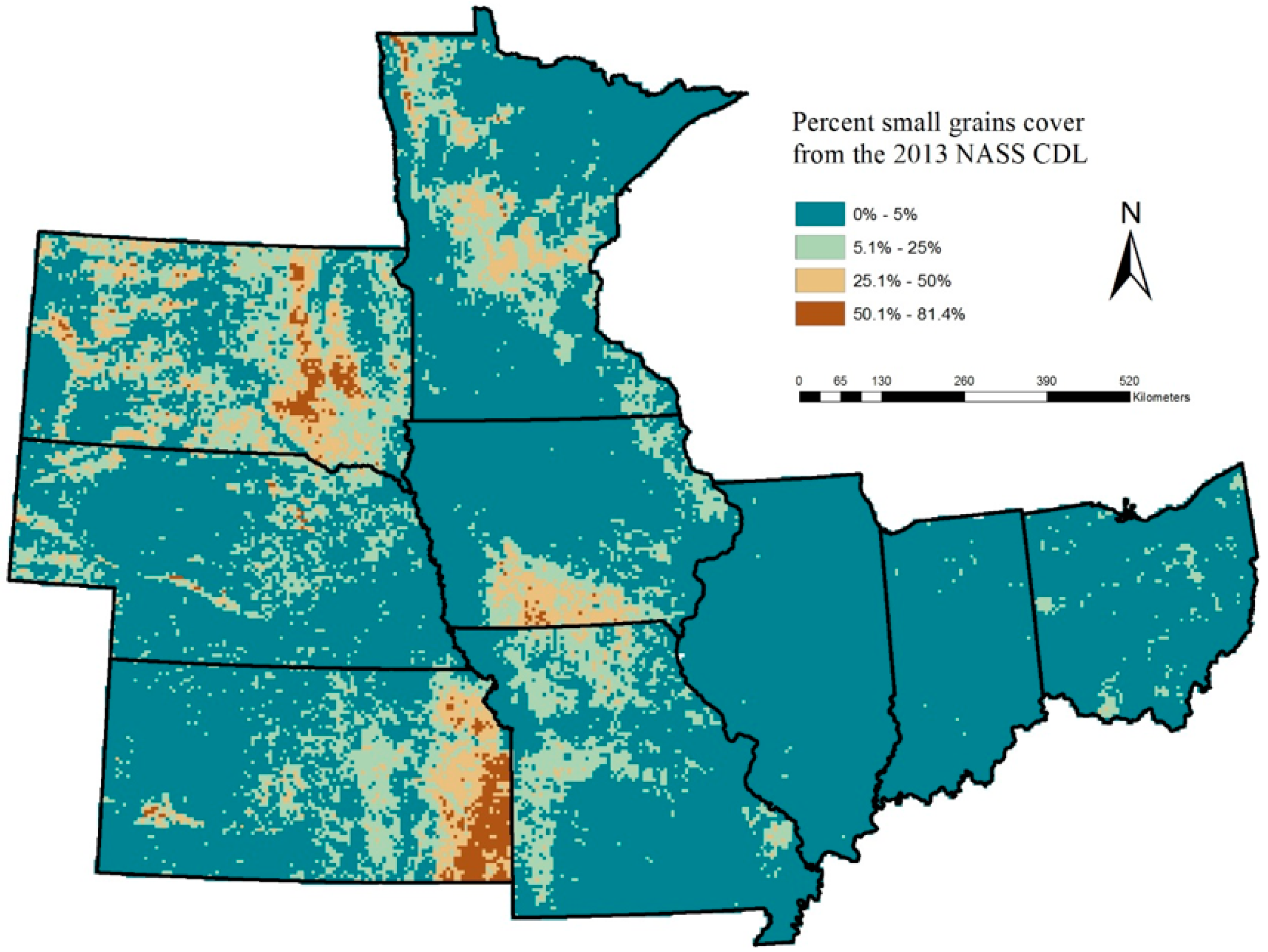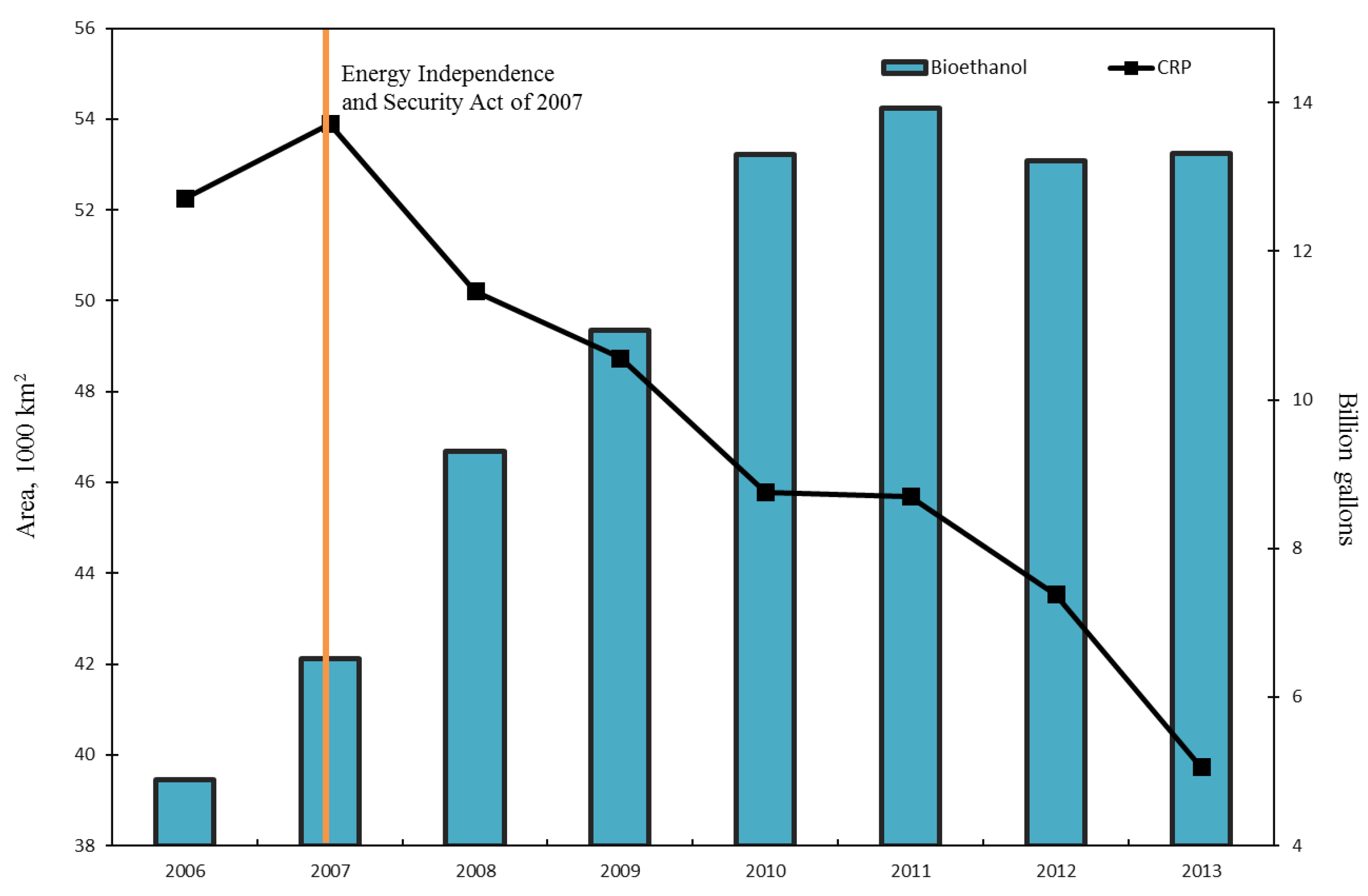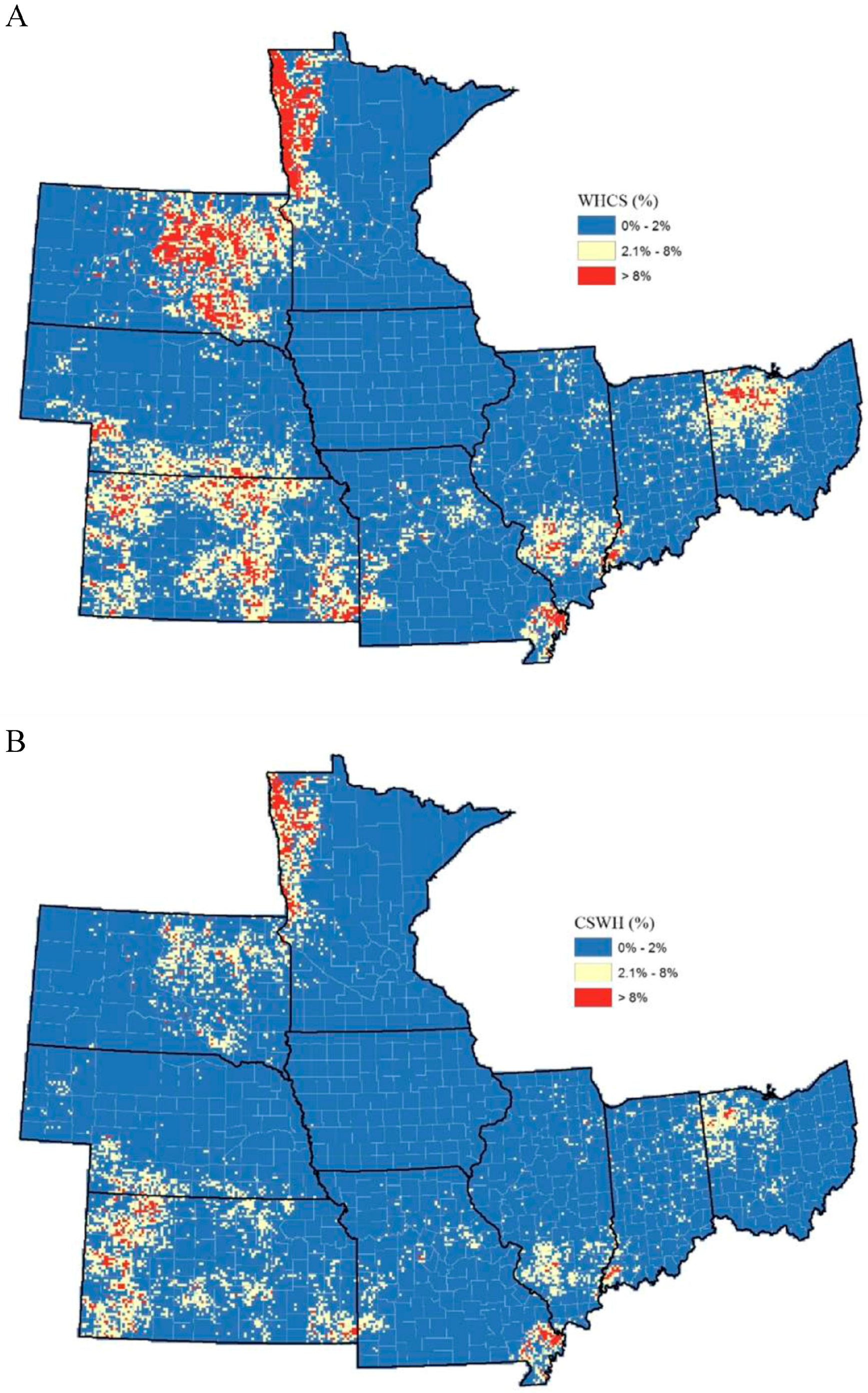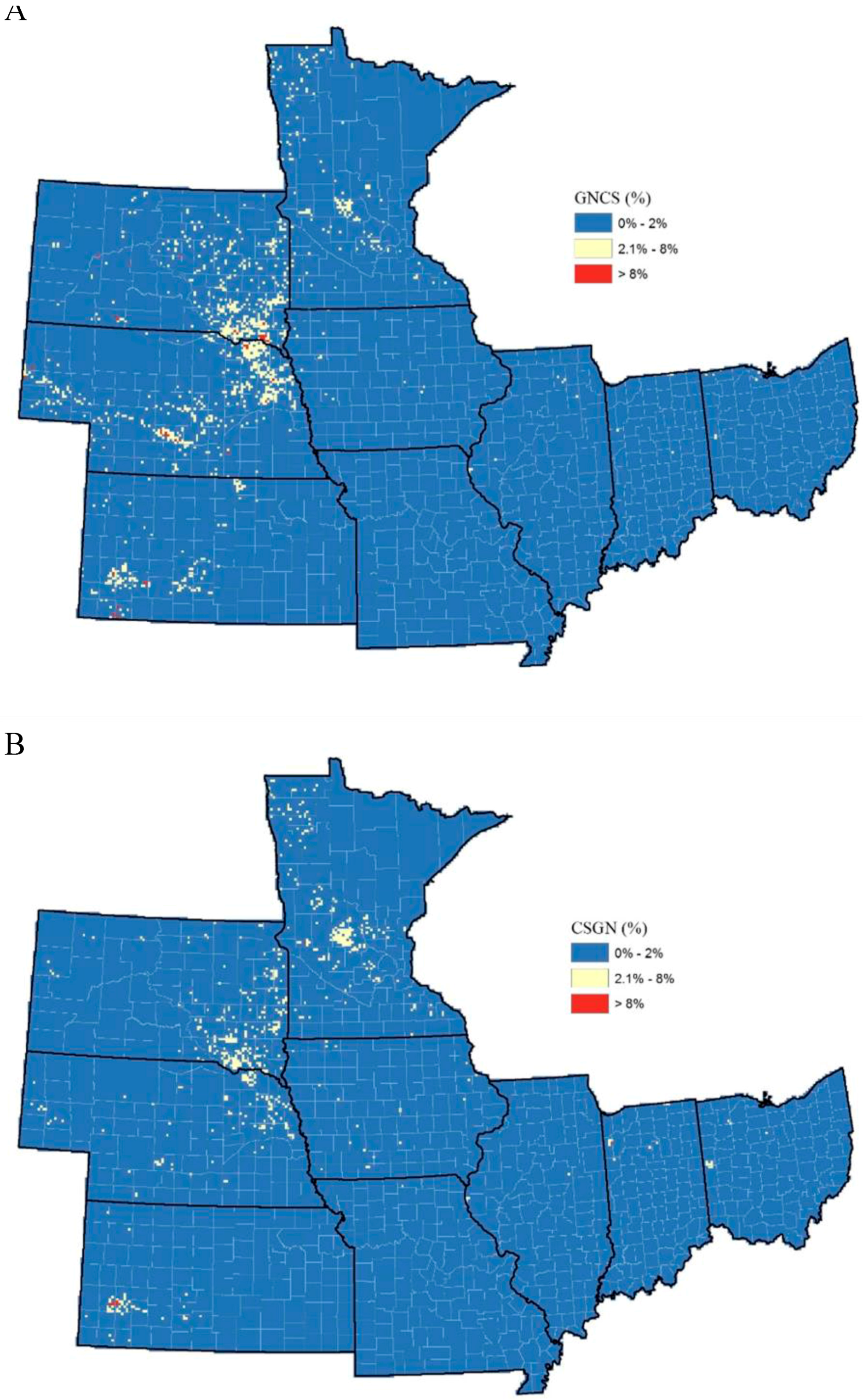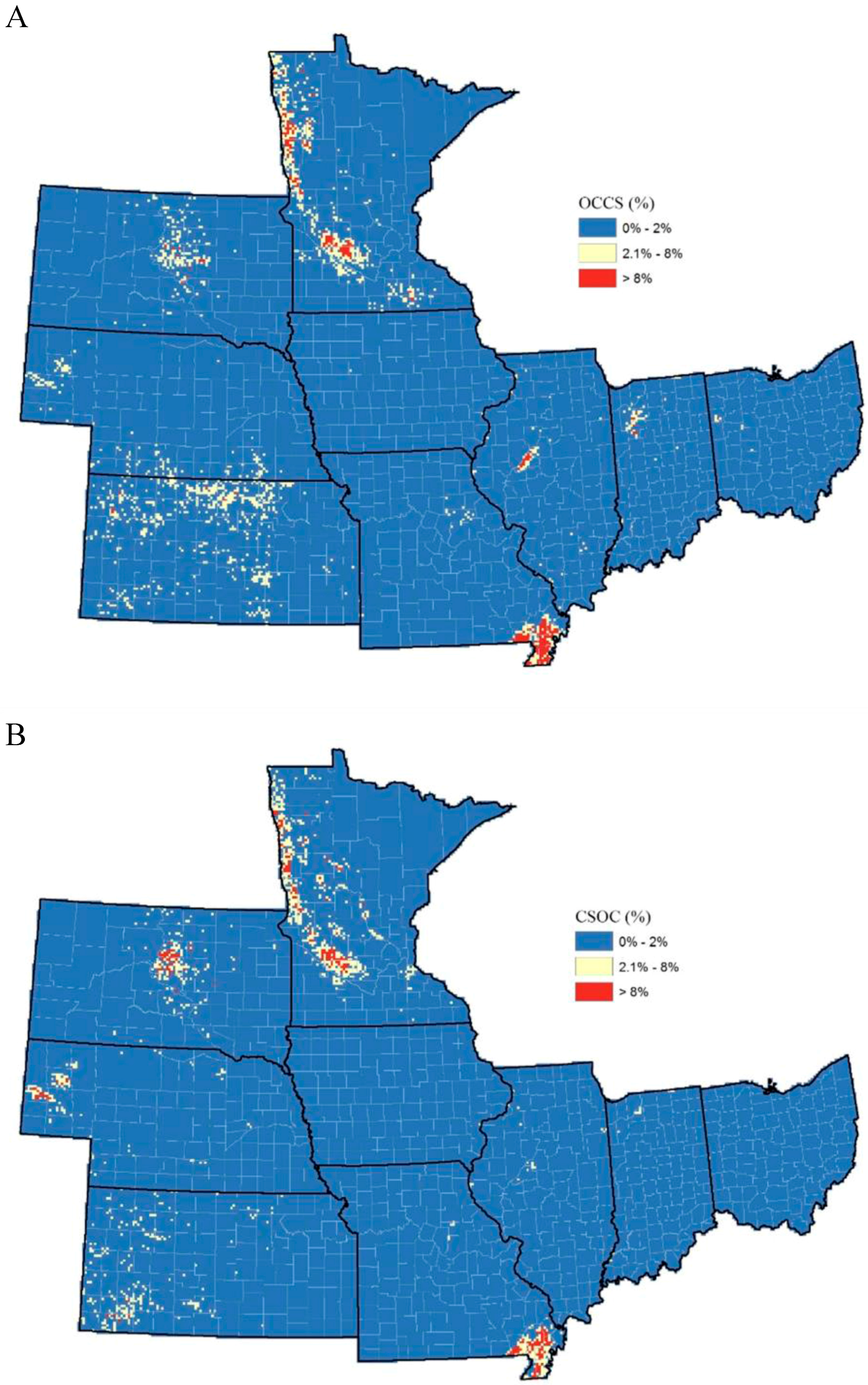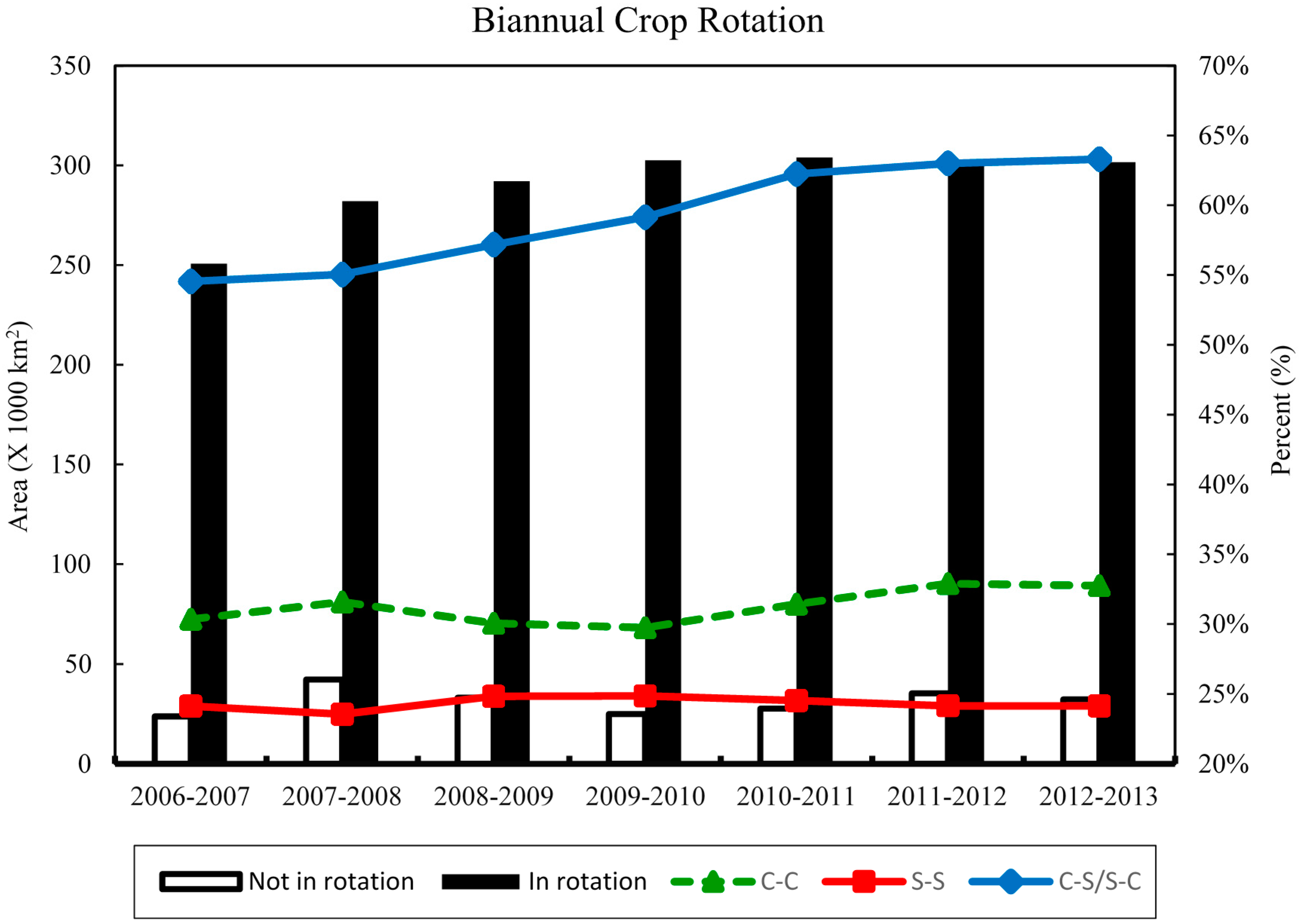1. Introduction
The world population of 7.2 billion in mid-2013 is projected to increase to 8.1 billion in 2025, and 9.6 billion in 2050, an increase of almost one billion more people within the next 12 years [
1]. Overall food demand is projected to double or triple by 2050 [
2]. In the meantime, U.S. fuel ethanol production increased by 731% from 1.6 billion gallons to 13.3 billion gallons between 2000 and 2013 [
3]. This large and rapid expansion of U.S. ethanol production resulted in increasing demand for corn, the primary feedstock for ethanol in the U.S., contributing to unprecedented rises in agricultural commodity prices [
4]. Data from the U.S. Department of Agriculture (USDA) National Agricultural Statistics Service (NASS) (2014) showed that the market prices of corn more than tripled in the past decade. During 2000–2013, the total U.S. corn production increased from 9.9 billion bushels to 13.9 billion bushels, while the total corn area increased from 79.6 million acres to 95.4 million acres [
5].
Higher commodity prices of corn have also encouraged farmers to change agronomic practices in the Midwest Corn Belt by adjusting crop rotations [
4]. Corn-soybean/soybean-corn rotation has long been implemented by U.S. farmers in the Midwest Corn Belt [
6,
7]. Corn and soybean may also be rotated with other forage crops like alfalfa or oats in different parts of the US [
6]. Crop rotation can have a number of significant benefits, including improved soil quality [
6,
8], increased soil carbon sequestration [
8], fewer crop diseases and pests [
9,
10,
11] and consequently higher agricultural productivity [
6,
8]. However, to produce more corn and capitalize on higher prices, farmers tend to shift to continuous corn planting [
12]. Reduced soybean production would mean higher price for soybean, which also tripled in the past decade. Therefore, in response to higher market price of soybean and production shift to corn, some farmers expanded or shifted to soybean production instead of corn production [
4].
The environmental and economic implications associated with changes in corn and soybean production have recently received increasing attention among scientists [
4,
13,
14,
15]. However, the magnitude of environmental impacts of corn and soybean expansions depends on the spatial and temporal patterns of crop distribution over time, as well as where these additional corn and soybean acres are located [
16,
17]. Since farmers react to price trends when making land use decisions, recent changes in the corn and soybean markets provide an excellent opportunity to examine agricultural expansion of corn and soybean and the impacts on other land uses, as well as changes in crop rotation patterns.
The U.S. Midwest Corn Belt (MWCB) is one of the nation’s most agriculture-intensive regions [
18]. The total area dedicated to corn or soybean production in the MWCB more than tripled between 1980 and 2014, covering roughly 82% of the entire nine-state area in 2014 [
5]. Increasing demand for food along with new demand for biofuels has caused and may continue to cause regional land use/cover and cropping pattern changes [
15]. Despite the significance of land use/cover change in the MWCB, information on where, at what rates, and which land cover classes were affected by agricultural expansion is generally lacking at the regional scale [
19]. Moreover, regional scale studies of agricultural land use/cover changes either utilize limited subsets of the Corn Belt (e.g., the Dakota Prairie Pothole Region in Johnston et al. [
20]) or preceded the doubling of corn and soybeans prices between 2006 and 2013, with the exception of one [
19]. Wright and Wimberly [
19] focused on grassland conversion from 2006 to 2011, whereas the study presented here considers all major land uses that have been affected by agricultural expansion, not just grassland.
To summarize, the objectives of this study are to: (i) analyze short-term (2006–2013) trends of major crops (i.e., corn, soybeans, and wheat) using the USDA Cropland Data Layers (CDL); (ii) quantify recent land use/cover changes between 2006 and 2013 using the USDA CDL; (iii) determine where and at what rates corn and soybean expansion has occurred between 2006 and 2013 by analyzing crop-specific satellite imagery of the USDA CDL; and (iv) examine and measure biannual crop rotation sequences between corn and soybean during 2006–2013 from the USDA CDL.
2. Materials and Methods
2.1. Study Site
Covering roughly 1,525,393 km
2, the U.S. MWCB is one of the nation’s most productive regions for farming and its agricultural productivity is critical to the U.S. economy [
18]. Nine states in the U.S. MWCB were selected for this study: Illinois, Indiana, Iowa, Kansas, Minnesota, Missouri, Nebraska, Ohio, and South Dakota (
Figure 1). These were chosen for analysis since they are the nine leading states in the United States in value of corn production [
5]. In addition, this region is a major producer of soybean, another Midwest cash crop. Together they account for more than 76% of the corn production and 73% of the soybean production in 2013 [
5].
The agricultural landscape of the MWCB was majorly shaped by changing agricultural practices in the region [
21]. For example, in southwestern Ohio, corn and soybean production has increased rapidly, while land in wheat, oats, and pasture decreased during the 1960s and 1970s [
21]. In the 1990s and 2000s, land in corn and soybeans even reached 90% of the total cropland area [
22].
2.2. Data Sources
The main data source for this study is the USDA CDL. The CDL is a crop-specific land cover product produced annually from satellite imagery since 1997, with specific focus on the type and location of crops planted in the contiguous U.S. Detailed crop classification maps at both county and state level can be freely downloaded from the CropScape website [
5]. More information about this project and metadata can be accessed through this website. The classification accuracy of major crop types can be as high as 90%. Therefore, the cropland data layers of nine MWCB states between 2006 and 2013 acquired from CropScape website were used directly in this study.
2.3. Data Processing
The CDL data for the years of 2006–2013 of all nine MWCB states were acquired in TIFF and IMG formats. The spatial resolutions for the years of 2006–2009 are 56 m, and 2010–2013 are 30 m. Initially, 2010–2013 data files were re-sampled into 56 m resolution to make all files the same spatial resolution. Then, all nine CDL files of the same year were mosaicked into a seamless annual data layer.
The classification scheme of CDL data files is relatively consistent from state to state or year to year, especially for CDL data files between 1997 and 2013. Equivalent classes that have different classification codes were combined (
Table 1), producing a total of 11 land use classes: corn, soybeans, wheat, small grains, other crops, open water, developed and barren, forest and shrubland, grassland, wetlands, and fallow/idle cropland. The cloud was reclassified as NoData and eliminated from all years to make sure that land use change analysis was only performed on locations present all years. Therefore, a total of 0.068 million hectares were covered by clouds and reclassified as NoData. After dropping out these cloud areas, the study area of all nine states (including non-agricultures such as open water, forest and shrubland, and wetlands) totaled over 150 million hectares. All geospatial data layers were analyzed in ESRI ArcGIS 10.3 (ESRI, Redlands, CA, USA).
2.4. Data Analyses
Major land cover conversions to corn/soybeans: Major land conversions to corn/soybeans included grassland, wheat, small grains, and other crops conversions. To determine grassland conversion in the MWCB over the period 2007 to 2012, we used the 2007 NASS CDL as a baseline map and compared it on a pixel-by-pixel base with the 2012 NASS CDL. Since we considered corn and soybeans as a general corn/soybeans class, corn and soybeans pixels in the 2012 NASS CDL were merged together. Then, the logical operator of subtraction was executed to identify pixels that changed from grassland in 2007 to corn/soybeans in 2012. All other land cover conversions to corn/soybeans were determined in the same way (as described in the last few sentences) as grassland conversion to corn/soybeans.
Crop rotation pattern investigation: Biannual sequences for corn and soybeans across the MWCB were analyzed using the CDL datasets: 2006–2007, 2007–2008, 2008–2009, 2009–2010, 2010–2011, 2011–2012, and 2012–2013. To determine biannual crop rotation pattern between corn and soybeans, each CDL data layer was reclassified. Possible rotation patterns for each biannual sequence include: corn-corn rotation (C-C), soybeans-soybeans rotation (S-S), corn-soybeans or soybeans-corn rotation (C-S/S-C). Specifically, the amount of area present in each unique rotation sequence, the amount of change between unique crop rotation sequences, as well as the frequency of biannual crop rotation patterns were determined for every location in the study area. The information generated allows for the identification of the most common crop rotation patterns in the region and associated temporal variations.
4. Discussion
In this study, satellite imagery of the MWCB were acquired from the USDA CDL at CropScape website. CDL data layer, a crop specific land cover product, is especially useful for our study as it provides spatially explicit data at an adequate temporal frequency and relatively high spatial resolution; it allows for a detailed analysis of when and where agricultural expansion of corn and soybean occurred [
5].
In general, the short-term trend analyses (2006–2013) of corn and soybeans acreage indicated continuous corn and soybeans expansion, whereas wheat decreased over the same time. Note that there was an abrupt increase in corn acres and a simultaneously decrease in soybean acres from 2006 to 2007. The amount of land planted to corn in 2007 climbed to about 245,334 km
2: a total of 172,933 km
2 (~70.5%) was newly added corn area and a total of 72,400 km
2 (~29.5%) was corn planted on corn between 2006 and 2007. The amount of newly added corn was directly related to the decrease in the amount of soybeans, wheat, and grassland/pasture. This increase was primarily at the expense of soybeans area, which accounted for roughly 77% of the total gain. Considering crop rotation practices from 2006 to 2007, we found that continuous corn cropping accounted for 32.4% (~72,400 km
2) and corn-soybeans rotation was 48.9% (~109,200 km
2) of the total corn area in 2006 (
Table 6). However, about 63.2% (~132,700 km
2) of 2006 soybean area was under soybeans-corn rotation but only 13.8% (~28,900 km
2) was continuous soybeans cropping from 2006 to 2007 (
Table 6). This explains why there was a large deviation in the amount of corn and soybeans planted, suggesting an increase in the intensification of corn since 2006.
Several studies [
4,
12,
13,
14,
17,
19,
23] have demonstrated that the prominent increase of corn acreage in 2007 and the subsequent years is likely attributable to both market conditions and policy incentives underlie the interest in ethanol. Crude oil prices reached a record high of $68 in the summer of 2006 (the average price in 2006 was about $59). With the rapid increase in gasoline prices, there was unprecedented increasing demand for ethanol, for which corn is a major input. Further contributing to the interest in ethanol, the Energy Independence and Security Act (EISA) of 2007 (Public Law 110–140) mandated to blend grain-based ethanol—made entirely from corn—into the national gasoline supply [
24]. Federal bioenergy policies, aimed at reducing greenhouse gas emissions and increasing energy independence, also provide incentives for boosting biofuel productions. When combined, these economic and policy drivers have contributed to agricultural expansion in the fertile MWCB.
Spatial analysis of agricultural expansion revealed continuous corn and soybean expansion at the expense of other land cover types, including grassland, wheat, small grains, and other crops. Of all, grassland loss was the greatest, totaling roughly 15,640 km
2 (~3.9 million acres). Grassland conversion to corn and soybean occurred dominantly along the western margin of the MWCB. Our finding is consistent with Wright and Wimberly [
19] in that cropland expansion has shifted westward to more arid western states, which potentially means higher agricultural input, in particular of irrigation. It might also encroach onto environmentally sensitive lands. As pointed out by the US Government Accountability Office (GAO), U.S. farm program payments provided strong incentives for landowners to convert grassland to cropland [
23]. In the meantime, drought-resistant varieties of corn and soybeans made possible by genetically modified engineering technology also contributed to a switch to corn and soybean production along the MWCB [
25]. Land conversion from grassland to cultivated croplands is associated with many environmental problems, including losses of grassland-dependent species [
26,
27], decreases of carbon sequestration [
26] and water quality [
28], and increases in soil erosion [
29]. Once native grassland loss occurs, the damage is hard to recover.
The analysis of the relationship between CRP land and grassland loss revealed two major points: (1) most of grassland conversion was due to a resumption of cropping on former CRP lands; and (2) corn and soybeans cropping has expanded beyond those lands previously protected by the CRP. This finding is consistent with previous studies [
4,
12,
19,
30,
31]. CRP was designed to protect highly erodible and environmentally sensitive acres of agricultural land to vegetative covers under 10 to 15 years’ contract [
32]. Much of the land entering the CRP was land formerly being devoted to row crop production. Therefore, by registering them under CRP, farmers can create a wide range of environmental benefits including the provision of improved habitat for grassland-dependent wildlife (e.g., pheasant) and other important ecosystem services [
33].
However, the amount of lands enrolled under CRP is subject to both landowner decisions and program caps as determined by Congressional budget [
34]. Landowner decisions change as the market prices of grain and fuel fluctuate. The emerging market of biofuels has boosted the market prices of major agricultural commodities, corn and soybean in particular [
31]. In turn, higher crop prices provide incentives for farmers to cultivate lands and Congressional efforts to increase agricultural production [
34]. Besides, increasing demand for land also lifts land value, which can further complicate the registration of CRP land. In fact, large amount of total CRP acres left the program since 2007. The wholesale loss of CRP land can have detrimental environmental impacts on wildlife and ecosystem services provided, especially in the context of global climate change. Therefore, government policy should be designed to promote more CRP enrollment due to its proven ability to conserve biodiversity even when there are fluctuations in agricultural commodity market. One option is to raise CRP payments so that it is as attractive as higher crop price. Higher CRP payments will certainly require substantially higher Congressional budget. Therefore, a change in targeting strategies is needed to ensure that the most sensitive land does not leave the program.
Wheat was the second most affected land cover class with a total net loss of 2.5 million acres. Wheat is also an important Midwest crop grown in the US, ranked right behind corn and soybean. The significant loss of wheat acreage to corn and soybean can be problematic given the importance of wheat as a direct food resource for human beings. The US also exports about half of its wheat production to international trade market [
5]. Such a significant shift of wheat production to corn and soybean can indirectly affect the food security of foreign countries which have rely heavily on wheat import.
When analyzing land use/cover change in the MWCB, we also analyzed annual crop rotation system under agricultural expansion. As aforementioned, high corn and soybean prices have affected three crop rotation systems: continuous corn, continuous soybean, and corn-soybean/soybean-corn. Throughout this analysis, there were obvious increases in both continuous corn cropping and continuous soybean cropping. Corn-soybean/soybean-corn rotation has long been considered beneficial to soil quality improvements and agricultural productivity [
6,
8,
9,
10,
11]. Therefore, a large transition into continuous corn or continuous soybean cropping would potentially lead to soil erosion and other environmental problems.
